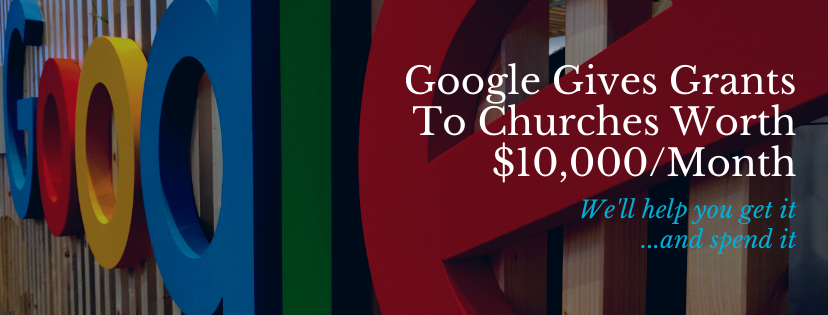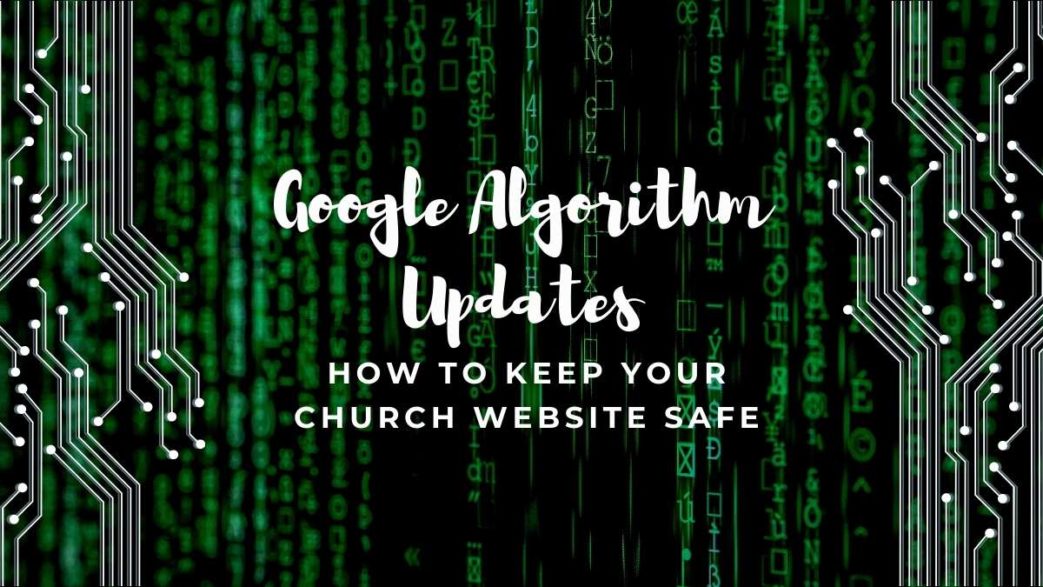Most site owners cringe when they think about Google algorithm updates, and for good reason. A single update can push your carefully optimized site to the second page of search results in a day.
You’ve likely heard the horror stories over time. While you can’t control these updates, there are things you can do to protect your site, no matter what Google changes.
Your church website doesn’t have to suffer with every update. Instead, establish a future-proofing strategy today.

Perform A Content Audit
The good news is this is probably the hardest thing on this list. A content audit is a necessary part of maintaining your church website. It also helps protect your from Google algorithm updates that may target problematic content and errors.
A content audit helps you to see what’s working best for your website and what’s holding you back. If you’ve never done this before, it can be a time-consuming task the first time. However, if you do it annually, it won’t take nearly as long.
The main purpose is to keep better control over your content. Find outdated content to rewrite, generate new ideas, see what your audience loves/hates and adjust your SEO strategy accordingly.
Torque offers a great outline for running a content audit. HubSpot also lists a step-by-step process using their free audit toolkit.
Update Outdated Content
Google wants to provide the most relevant search results to users. This means over time, some of your content might not be as relevant as it once was.
As you go through content on your website, ensure it’s up to date. Or, find ways to make it evergreen. For instance, if you have a post entitled “Getting Through Christmas 2001 Without Losing The Spirit,” Google sees this as outdated. Updating the content a little and changing the title to “Getting Through Christmas Without Losing The Spirit” changes this to a fresh, evergreen article.
Also, check your website’s content. When was the last time you updated anything outside of your blog? Are your events current? Has your church changed locations? Are staff members still the same?
Focus On Loading Times
No matter what Google algorithm updates focus on next, page loading speeds will always be a major factor. No one likes waiting on a website to load. In fact, it only takes seconds before a visitor decides to leave if your site is too slow.
When visitors are leaving your site too quickly, Google assumes something is wrong. This obviously reflects negatively on your rank.
It’s important to constantly work to improve your site’s loading time. A simple tip is to reduce image sizes so they load faster and allow text to load, even if images and videos aren’t fully loaded. This gives visitors something to distract them while the rest of your site loads.
A slow loading site makes a horrible first impression. If you can impress your visitors quickly, you’ll also impress Google, no matter what updates come next.
Make Your Site User Friendly
The May 2020 Google algorithm update focuses on the user experience, or UX. Since Google is always focusing on ways to improve search for users, it makes sense to make your church website as user-friendly as possible. After all, if visitors don’t like your site, it’s not going to rank well.
As already mentioned, page loading speeds are an important part of the user experience. In fact, the May 2020 update has a new metric called Largest Contentful Paint (LCP). This applies to the loading time of your page’s most important element. Google wants these elements to load within 2.5 seconds.
Of course, a user-friendly site also has to have easy to use navigation, both on desktops and mobile devices. Focus on making your site intuitive and easy to read. Also, ensure it works well on all types of devices.
Often, site owners focus so much on impressing Google, that they forget about the users. Instead of worrying so much about algorithm updates, focus on what your visitors want and need. Even if it’s not part of a Google update yet, it likely will be soon. Then, your site is not only protected, but fully prepared.

Stay Updated On Google Algorithm Updates
It’s always a good idea to stay abreast of any Google algorithm updates. While you can prevent your rank from falling, new metrics in updates show you how to stay competitive. Since you need to update your website to better appeal to visitors, use the latest updates to see exactly what users are wanting and needing.
Taking a proactive approach to updating your church website helps protect you from falling behind as future algorithm updates are released. Plus, you don’t have to guess as to what might be coming. You’ll already know.
For instance, when Google first started introducing mobile compatibility as a ranking factor, sites that immediately started updating their sites were ready when mobile became a much more important ranking factor. Sites that waited until later saw their rank drop. While trying to catch up, other sites took their place and became more competitive.
Search Engine Land and Search Engine Journal both list past algorithm updates. Plus, both are great sources for staying current on any all changes to Google’s search engine.
Google’s also making core changes and requirements much clearer to site owners. Web Vitals is a new Google initiative aiding site owners in seeing which metrics are most important along with introducing new metrics. You can check these out regularly and also use the included tools to see how your site measures up.
Use Google Webmaster Tools
Broken links, 404 errors, pages not loading correctly and other issues all hurt your rank. Since you never know which issues might become a bigger ranking factor in Google algorithm updates, you have to keep an eye on your site to make sure it’s running smoothly at all times.
The good news is Google provides tools to help you improve your church website’s performance. Google Webmaster Tools are free for site owners to use. These are a variety of optimization tools that help you quickly find errors. You also get suggestions on how and where to improve.
While you might not realize certain pages of your site aren’t performing well, Google Webmaster Tools helps you uncover these issues. There are also free courses to help you better understand how to maintain and monitor your website.
Write High Quality, Useful Content
When Google Panda hit in 2011, numerous sites went under due to what Google called “thin content.” Typically, the content was stuffed with keywords or was so generic it didn’t give readers anything useful to take away.
However, websites that already focused on creating high quality content that was useful to readers were unaffected by this algorithm update. The lesson – high quality content always wins out.
One of the best ways to protect your church website from future Google algorithm updates is to consistently write high quality, useful content for your readers. It’s a much better strategy to write one longer post that contains valuable information for your readers than try to churn out shorter, lower quality posts each day.
This type of strategy helps you in more ways than one. First, even updating once a week shows Google that your site has fresh content regularly. Second, readers have a reason to keep coming back. Third, great content keeps visitors on your site longer (a Google ranking factor). Finally, useful content gets shared more, building your church website’s visibility and reputation.
Take the time to develop a blogging strategy that works well for your church. A solid blogging strategy has always been a great future-proofing method.

Stay Active On Social Media
While it might not seem like it, social media has an impact on your search engine rank. At the time of writing, social media hasn’t been listed as an official ranking signal, but keep in mind that Google keeps a lot of factors secret, which doesn’t necessarily help site owners.
However, Google has shown interest in social media in terms of ranking a site. The search giant even filed a patent around verifying whether social media accounts were real or fake. Meaning, a fake account filled with fake followers would hurt a site’s rank while a legitimate account with numerous followers and interactions would rank higher.
Your church doesn’t always have to stay on top of all the latest trends, but Google does pay attention to them. Hence the interest in social media as a ranking factor.
When a trend continues to grow, pay attention to it. In this case, social media is a trend that continues to grow and evolve. Even if Google doesn’t add it as a major ranking factor, it can affect your website.
Stay active on social media to build a church community. Post regularly and interact with your followers. Link back to your church’s blog and share other useful content. Since many people might check out your church on social media first, it’s a good idea to have an active presence.
Make a great first impression on social media and your followers will visit your website too. Use social media to build a larger audience both on the platform(s) you choose and your website.
Use Images And Videos
You might have thousands of words in a blog post, but readers will still tell you it’s missing something – visuals. People love visuals, whether it’s images or videos.
For busy site visitors, images help break up long blog posts, making it easier for them to find their place if they have to stop reading and come back to it. Or, opt for a video that breaks down your blog post’s main points in just a few minutes, with no reading necessary.
You don’t have to give up text. In fact, you definitely shouldn’t. After all, text gives Google more information to help you rank. That’s why videos should have a clear description with your target keyword. And, you also need to name both images and videos with your keywords in mind.
Videos are growing in popularity and they help people remember information more. Plus, if you create high quality videos, people will want to share them. It’s a win-win.
Focus On Local SEO
As a local business, your church has to focus on local SEO. Often, people find churches using local search criteria, such as “churches in city, state.” This means Google is also looking for church websites that are optimized for local searches.
An easy way to protect your church’s site from Google algorithm updates is to consistently optimize for local search as well as general search. A great way to do this is to keep your Google My Business listing updated.
Even Google states that this is a great way to improve and maintain your search rank. It’s a free tool provided by Google. It helps people find you and your church’s website. Since it’s free, there’s no real reason not to use it.

Use Keyword Phrases Naturally
Google is constantly cracking down on low quality content. A major sign of lower quality content is stuffing in keywords. Often, the keywords don’t even make sense.
Instead, be smart about your keywords. Pick one or two (at most) to target in a blog post or page on your website. Then, only use them naturally.
You don’t have to add your keywords to every sentence or paragraph. Using it every hundred to few hundred words is more than enough. Ideally, pick a short phrase that people would actually type in or say to Google. This is easier to add in naturally to your content.
By going with this strategy, you avoid getting pinged for overusing keywords. Plus, your content becomes easier to find while getting ranked higher over time.
Guest Blog For Reputable Backlinks
Backlinks have always been a major Google ranking factor. However, they have to be reputable backlinks that are relevant to your site. That’s why sites that bought thousands of backlinks to any and every site they could have dropped or even been removed from search listings.
The best way to get reputable backlinks that help your church’s site and help protect you from algorithm updates is to guest blog. By giving something valuable to another reputable site, you gain a backlink and a larger audience.
A well-designed church website is key to staying safer from future Google algorithm updates. Contact us today to see how our sites help your church succeed.




